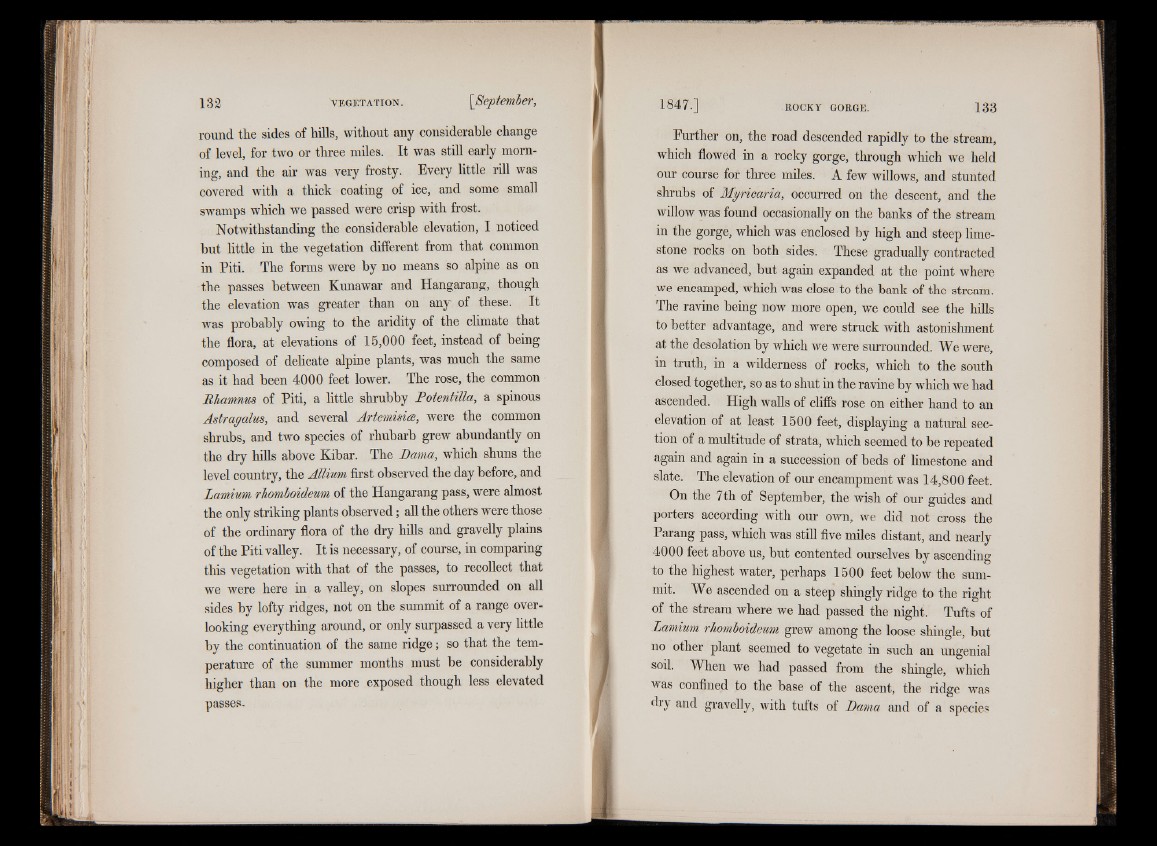
round the sides of hills, without any considerable change
of level, for two or three miles. It was still early morning,
and the air was very frosty. Every little rill was
covered with a thick coating of ice, and some small
swamps which we passed were crisp with frost.
Notwithstanding the considerable elevation, I noticed
but little in the vegetation different from that common
in Piti. The forms were by no means so alpine as on
the passes between Kunawar and Hangarang, though
the elevation was greater than on any of these. It
was probably owing to the aridity of the climate that
the flora, at elevations of 15,000 feet, instead of being
composed of delicate alpine plants, was much the same
as it had been 4000 feet lower. The rose, the common
Bhamnus of Piti, a little shrubby Potentitta, a spinous
Astragalus, and several Artemisice, were the common
shrubs, and two species of rhubarb grew abundantly on
the dry hills above Kibar. The Dama, which shuns the
level country, the Allium first observed the day before, and
Lamium rhomboideum of the Hangarang pass, were almost
the only striking plants observed; all the others were those
of the ordinary flora of the dry hills and gravelly plains
of the Piti valley. It is necessary, of course, in comparing
this vegetation with that of the passes, to recollect that
we were here in a valley, on slopes surrounded on all
sides by lofty ridges, not on the summit of a range overlooking
everything around, or only surpassed a very little
by the continuation of the same ridge; so that the temperature
of the summer months must be considerably
higher than on the more exposed though less elevated
passes.
Further on, the road descended rapidly to the stream,
which flowed in a rocky gorge, through which we held
our course for three miles. A few willows, and stunted
shrubs of Myricaria, occurred on the descent, and the
willow was found occasionally on the banks of the stream
in the gorge, which was enclosed by high and steep limestone
rocks on both sides. These gradually contracted
as we advanced, but again expanded at the point where
we encamped, which was close to the bank of the stream.
The ravine being now more open, we could see the hills
to better advantage, and were struck with astonishment
at the desolation by which we were surrounded. We were,
in truth, in a wilderness of rocks, which to the south
closed together, so as to shut in the ravine by which we had
ascended. High walls of cliffs rose on either hand to an
elevation of at least 1500 feet, displaying a natural section
of a multitude of strata, which seemed to be repeated
again and again in a succession of beds of limestone and
slate. The elevation of our encampment was 14,800 feet.
On the 7th of September, the wish of our guides and
porters according with our own, we did not cross the
Parang pass, which was still five miles distant, and nearly
4000 feet above us, but contented ourselves by ascending
to the highest water, perhaps 1500 feet below the summit.
We ascended on a steep shingly ridge to the right
of the stream where we had passed the night. Tufts of
Lamium rhomboideum grew among the loose shingle, but
no other plant seemed to vegetate in such an ungenial
soil. When we had passed from the shingle, which
was confined to the base of the ascent, the ridge was
dry and gravelly, with tufts of 1lama and of a species